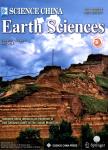Three-dimensional thermo-rheological structure of the lithosphere in the North China Craton determined by integrating multiple observations: Implications for the formation of rifts
Three-dimensional thermo-rheological structure of the lithosphere in the North China Craton determined by integrating multiple observations: Implications for the formation of rifts作者机构:State Key Laboratory of Geodesy and Earth’s DynamicsInstitute of Geodesy and GeophysicsChinese Academy of SciencesWuhan 430074China Institute of Geophysics and GeomaticsChina University of GeosciencesWuhan 430074China Department of Earth and Atmospheric SciencesSaint Louis UniversityMO 63108USA
出 版 物:《Science China Earth Sciences》 (中国科学(地球科学英文版))
年 卷 期:2020年第63卷第7期
页 面:969-984页
核心收录:
学科分类:070904[理学-构造地质学] 0709[理学-地质学] 07[理学]
基 金:supported by the National Natural Science Foundation of China(Grant Nos.41731072,41574095) the National Key R&D Program of China(Grant No.2017YFC1500305) Most figures were prepared with the Generic Mapping Tools(Wessel and Smith,1998)
主 题:North China Craton Thermal structure Rheological structure Lithospheric deformation Rift
摘 要:The lithosphere of the North China Craton(NCC)has experienced significant destruction and deformation since the Mesozoic,a notable feature of which is the widespread extensional structure and lithospheric thinning in the eastern *** the thermo-rheological structure of the lithosphere is one of the main factors controlling these dynamic processes,a threedimensional thermo-rheological model of the present lithosphere in the NCC was developed based on a geophysical-petrological method using a variety of data,and its relationship with the extensional structures and the formation of rifts was further *** results show that the western NCC is characterized by thick lithosphere,low Moho temperature(TMoho1).The deformation of the western narrow rift is consistent with the localized deformation dominated by the strength of lithospheric *** the other hand,the lithosphere in the eastern NCC is characterized by extensive thinning(with lithospheric thickness of about 80–110 km).However,the decrease of lithospheric strength is not uniform,with high strength(10×1012 Pa m)observed in some areas(such as the Bohai Bay Basin and Hehuai Basin).Most of the eastern lithosphere is characterized by high TMoho(600–750°C)and low Sm/Sc(1),which is inconsistent with the widespread extensional structure in the eastern *** results from palaeo-geothermal and petrological studies,we developed a thermo-rheological structure model of the lithosphere at different evolutionary stages of the NCC,and suggested that the eastern NCC had a significantly thinned and weakened lithosphere in the early stages of the formation of the rift,leading to a regional distributed extension deformation dominated by crustal strength,which eventually evolved into a series of wide ***,the cooling and accretion of the lithosphere in the subsequent stages significantly increased the strength of the



